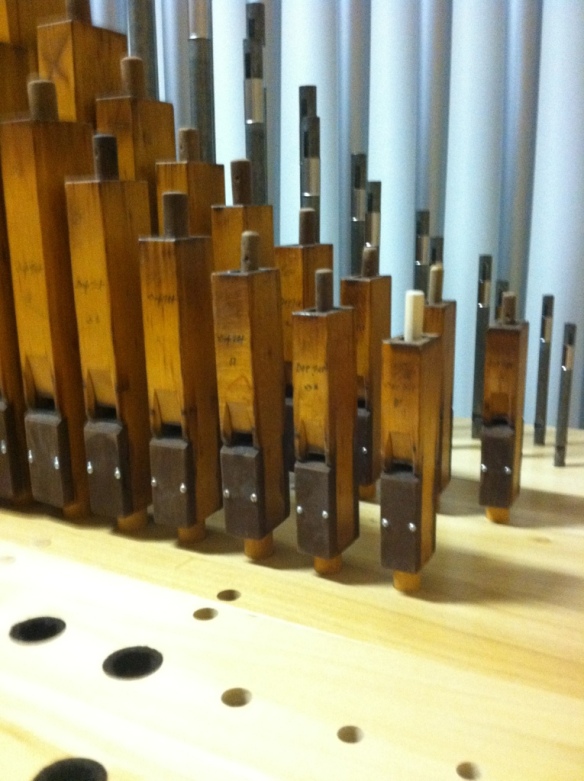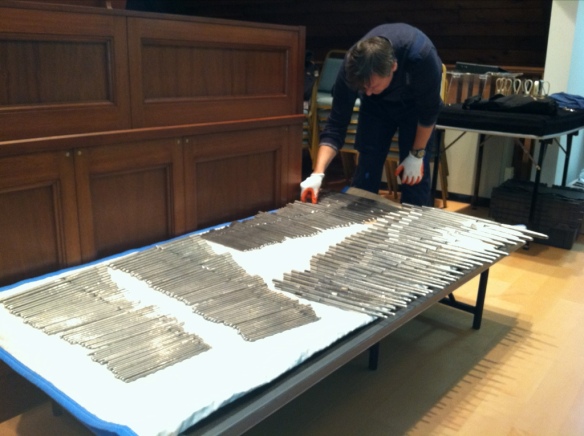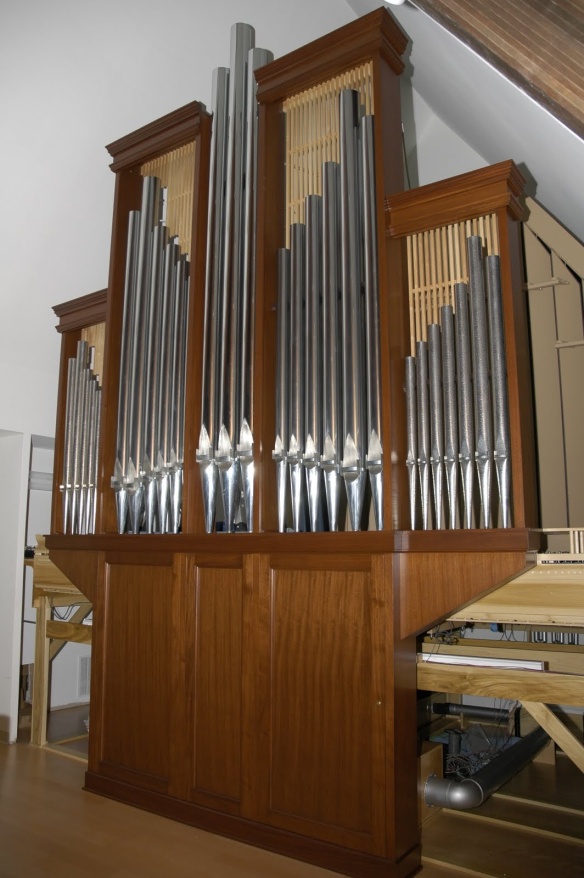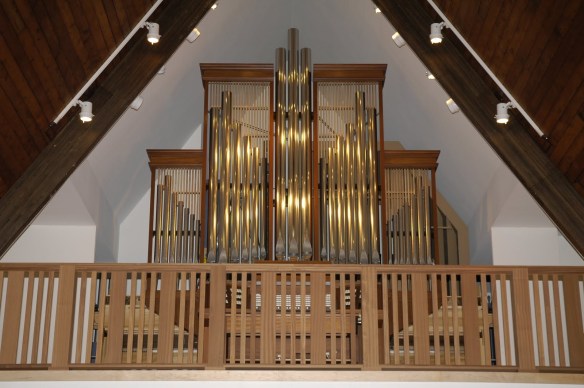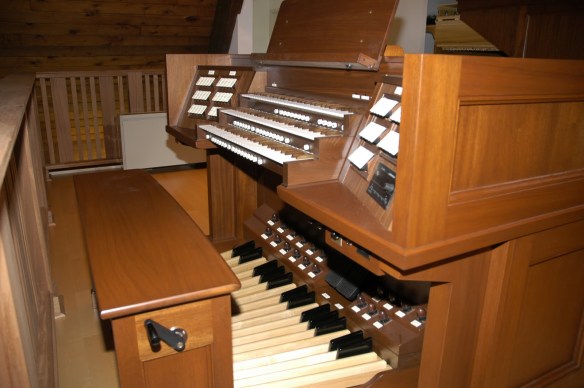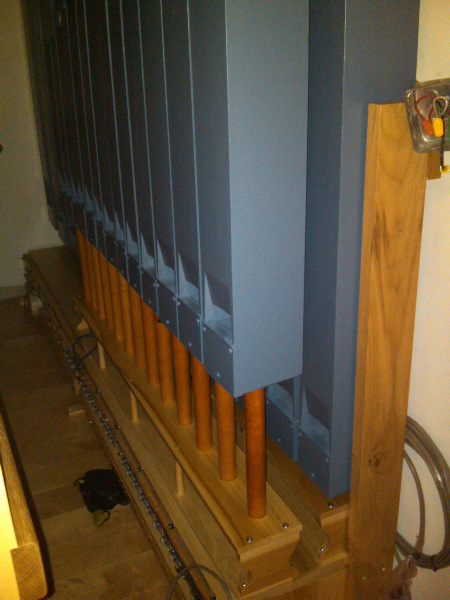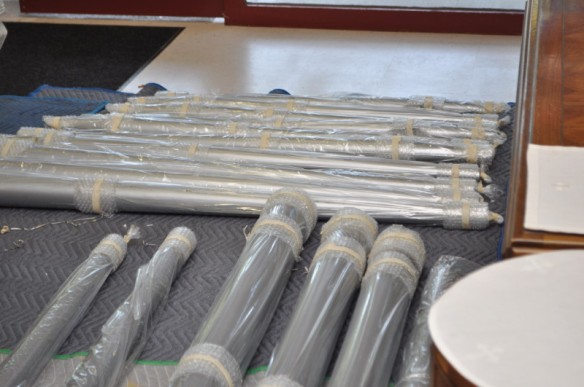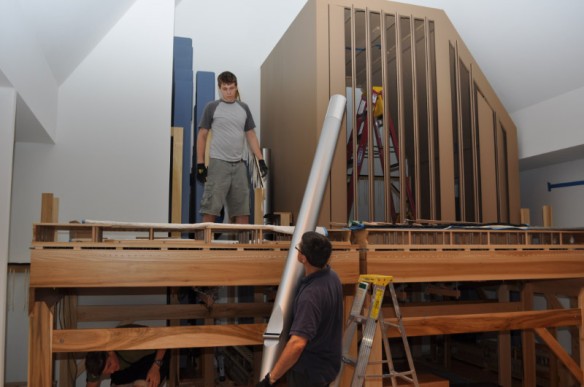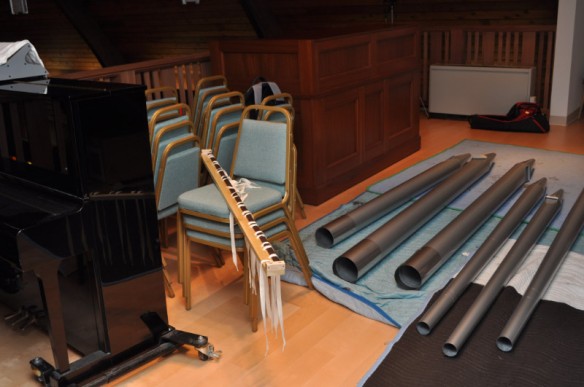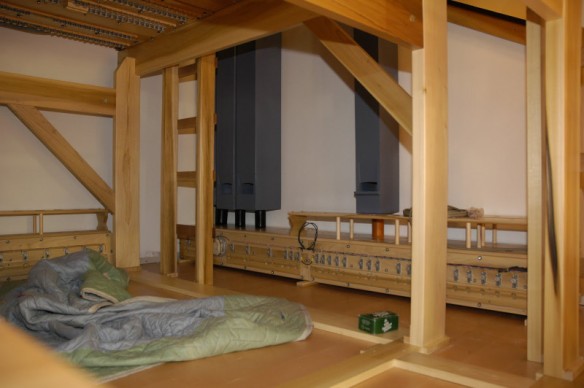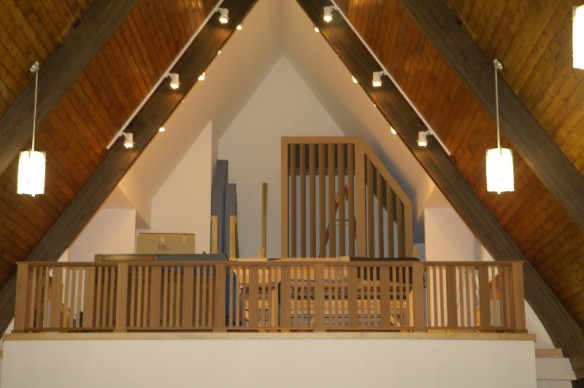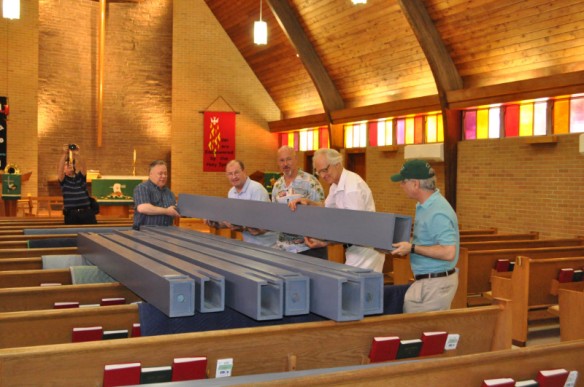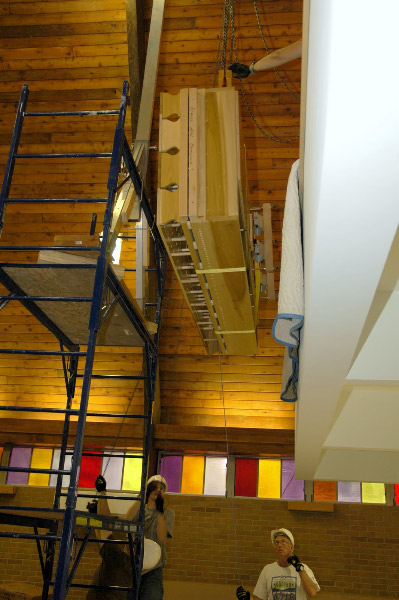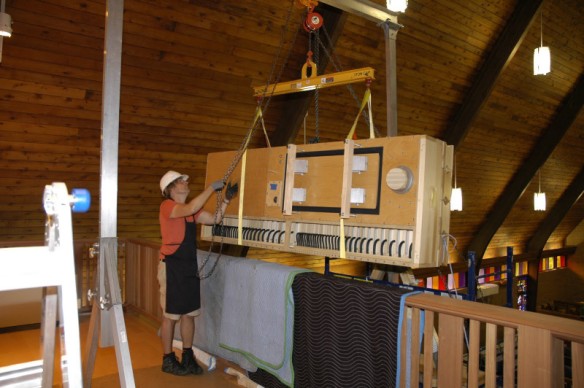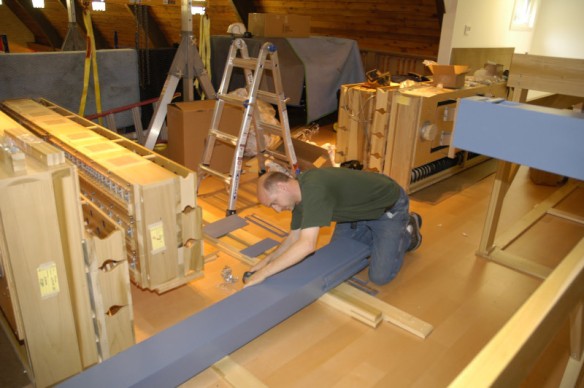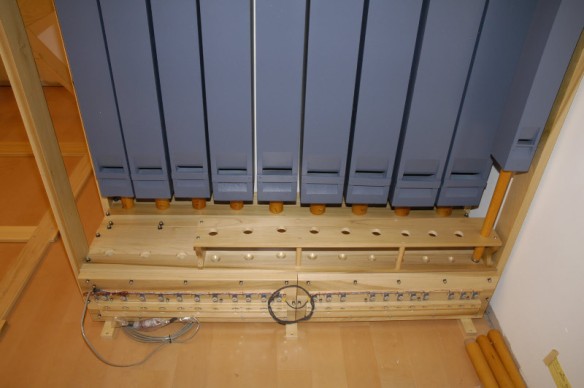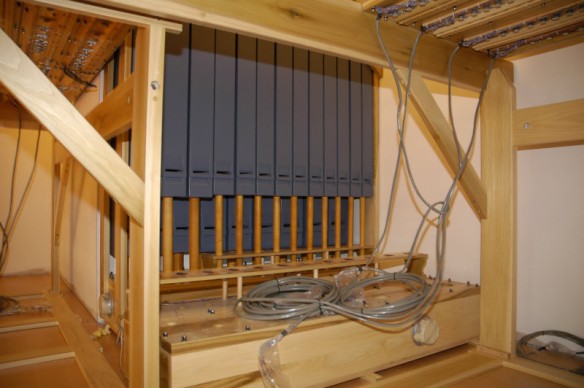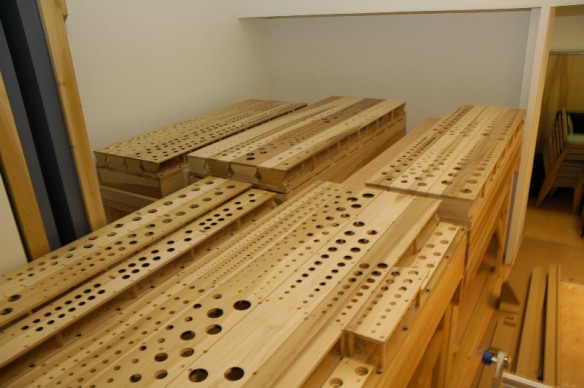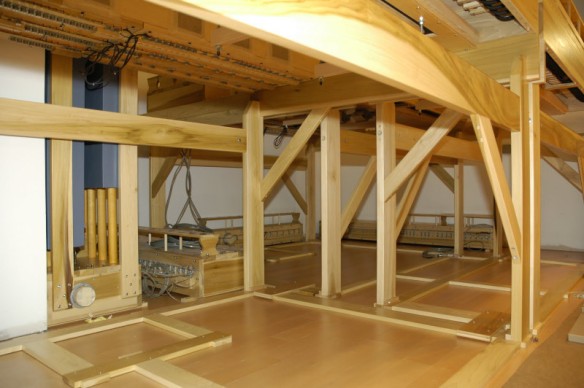This doppel flute sounds wonderful
Image
The four rank Great mixture just before racking
Image
After a month of racking and tuning
…all good things are worth the wait! The weekly process has been to rack the pipes, do a basic tuning, then the tonal finishing takes place. At this point, everything is up except for those wonderful Gluck reeds. The mixtures were just installed a few days ago. Really sounds like an organ now. Here’s several ranks laid out, ready to be racked:
…at the end of the day…
Albert Jensen-Moulton, of Gluck Pipe Organs, took this photo of the installed facade pipes… lots more behind the scenes work to be done, including the racking of the majority of the pipework and final electrical and winding hook-ups, before voicing is ready to begin. Read on for more details in the posting below this one…
…it’s not just a facade…
Monday was a red-letter day, as the casework for the front of the organ arrived, which is in a beautiful mahogany, to match our console and soon to be stained balcony rail. The team assembled the case and racked the facade pipes, which are of highly polished zinc. It’s always amazing to people that organ pipes are made of tin, lead, or zinc, or a combination of those metals. They have proven their tonal worth through the centuries, and are the best materials for the tonal finishers to work with. Here’s a photo courtesy of KW Janne (as I am on vacation for a few days) showing the facade pipes and case…
The woodwork above the pipes is known as “pipe shades”… it complements the same motif in the Gluck-designed balcony rail. In the following picture, you can see the view in the loft; the rest of the pipes will be installed during the voicing procedure, one or two ranks at time, so it will get quite filled up behind the display pipes.
You can see the wind supplies on the floor behind the casework. To the right and left of the case will be special organ cloth screening, which is acoustically transparent, but will pull all of the elements of the installation together visually. Organ building is truly a combination of artistic design, structural engineering, acoustic planning and aesthetic illusion (!) Below, the same pipes illuminated by the balcony lights; this is completely adjustable and will really look terrific during the various seasons of the church year.
A word about organ “facades”… at one point in organ history (about 100 years ago) it was quite fashionable to have elaborately stenciled pipes in front of an organ that was basically hidden in deep chambers…some of these pipes (in some cases, all of them) were dummies which were used for decorative purposes. Occasionally, in later years, electronic organs used speakers hidden behind these same facades to give the illusion that a real pipe organ was in the loft. Our organ facade is made up of real, speaking pipes that are called the 8′ Praestant, which means pipes literally “in front” of the rest of the organ. These pipes will be among the most used in the whole instrument, forming the backbone of the Great principal chorus, which will lead our hymns so well.
The console is in place (although it is quite easily movable) and the pedal board and adjustable bench assembled. That adjustable bench is no mere minor convenience; Not only do different organists need different heights to play comfortably, organ literature is played using two distinct schools of technique; one uses a toes-only approach (music of Bach and his predecessors) and the other uses a combination of toes and heels. This requires a re-setting of the bench height, often within the same service. In a few months, come on up to the loft for a demonstration of this, although we will be having several Adult Forums that will include this rather fascinating subset of organ trivia. Thanks again to KW for the great photos!
time to rumble…
…here’s a photo of the racked 16′ Infrabass, which was a rank from our previous organ. It’s been painted blue to match the 16′ Holz Violon, which is on the opposite side of the organ chamber. The Infrabass is a “stopped” set of pipes, in that the top of the pipe is covered by a movable stopper. This effectively doubles the length of the pipe, as the air has to travel twice the difference. The musical effect is that you only need to make a pipe 8′ long to get the same frequency as a 16′ pipe. The difference between stopped pipes and open ones (that are double the length) is that the tone is more subdued with the stopped rank. These two ranks will be a great combination underneath the other sounds of the new organ. Other notable work this last few days has been the installation of the slider motors, which will operate whenever the organist selects a rank at the console, and the completion of mechanical work in the swell box. Also, much of the winding systems are now in place underneath the wind chests. Next in line will be the delivery of the front case of the organ as early as Thursday. If you come up to the loft after the 9:30 service, you can get a free tour!
…rack ’em up!
This week will see some of the larger ranks placed in their final homes… they’ll make the trip from their box, get un-wrapped, be carried up the stairs, and onto the chests they go. You can see that the builders enjoy this part of the job!…
That board you see in the above picture has cloth tie-downs for the upper parts of the pipes… chosen to not interfere acoustically with the pipe. Some of the pipes you see above are the pedal Spitzflote pipes, which have a slightly conical shape to them (smaller at top than at the base of the pipe.)
You can see the “roller” at the mouth of the pipes above… this smooths out the airflow and makes a different timbre.
…that’s swell…
By the end of the first week, you can see the structure of the Swell box… you will not be able to see this after the organ is completed, as it will be behind the case and facade pipes. The Swell is a division of the organ that enables pipes to be “under expression”. A foot control on the organ console controls the opening and closing of the swell shades. Not only volume, but the timbre of the pipes change subtly as the shades operate. Lights will also be installed in the interior, as it can get pretty dark in there!
To the left of the Swell division will be the Great. This division normally contains the pipes that will be accompanying our hymns and liturgy. Volume and timbre control here is governed by the selection of ranks by the organist. More on that as we see those pipes go in. In front of the Swell will be the Positiv, which is a smaller division that provides solo stops and pipes that will accompany the choir and soloists. Many of the ranks from our previous instrument will now be found in the Positiv.
You can see in the photo some of the other bass pipes, towards the right wall. These are from our previous organ, and will provide good support for the rest of the organ, along with the Holz Violone on the left wall. The pipes, although supported on the wall, actually rest directly on the windchests.
Along the back wall will be the pipes of the 16′ Basson, which is part of a rank of pipes that emulate the oboe and bassoon of the orchestra. You can also see in the photo above the built in ladder for access to the Swell box.
A look at the progress from the floor of the sanctuary:
…remember that pretty much none of what you see in the above photo will be visible when the organ is completed. The console is resting temporarily on it’s casters towards the left. It will be movable to allow the placement of the various instrumental and vocal forces used throughout the year. Thanks again to KW Janne for these photos.
Installation continues…
I’ve posted here some of KW Janne’s great pictures from today… with a bit of commentary for you organistas!
First, let’s take another look at some of Sundays’ carried in pipes…
These pipes are about 100 years old… they are slender in scale, which gives them what organ-builders call a more “stringy” sound… More of the higher harmonics are emphasized. This rank of pipes will combine with the 16′ Infrabass, (which is from our previous instrument) to provide a solid under-pinning to our hymns.
In order for the pipes to speak, air (or, wind, as it’s called) will need to get to each one. This is accomplished via the windchests, which are beautifully crafted for our instrument. Here’s how they get over the balcony rail…
…and over the top!
The 16′ Holz Violone will be fed from a small chest that will rest on the balcony floor. Those walls that were created by our General Contractor will now become, literally, a part of the organ, as they will help “propel” the sound out into the sanctuary. Here’s how the pipes filled the chest… brought up one at a time by the organ team.
Each pipe will have it’s tuning slide re-installed by Albert, and carefully placed on the chest.
…and then it joins it’s brothers (sisters), ready to worship!
As the organ space fills up, it will get quite crowded in there…just enough room for maintenance and tuning in the future!
The other windchests were also put into position today. There are two basic types being installed. The “slider” chests use a design that is literally hundreds of years old, where the air is allowed to enter the selected pipe rank by holes in a long piece of wood, called a “slider”… the modern element is that these sliders will be moved by a small electric motor, rather than by a direct mechanical linkage from the organ console. The other type of chest, the “unit” chests, will allow a single rank to be played at different pitches. These chests have a separate valve per note. Here they are, ready to receive their pipes.
You can see the various sizes of holes…You can make out separate “planks” of wood on the top of the chests. Each plank will generally hold one rank of pipes. In our organ, that’s usually 58 pipes, one for each of the notes on an organ keyboard.
Underneath the chests, what is now empty space will soon be filled in by supply windways, and air reservoirs… you can see that the structure is definitely built to last, with a quality that IKEA can only dream of!
The contractor-installed maple flooring will also do it’s part to reflect the sound of the pipes into the nave of the church. Practice up your singing!
For reference, here’s where we started, just two days ago:
…an artist’s canvas, if you will.
Incidentally, many people in the “organ world” are checking in to this installation and organ, and are very excited by what Sebastian is being allowed to do here. We’ve heard from internationally known organists as well as fellow organ builders. It’s often a very supportive group of colleagues.


